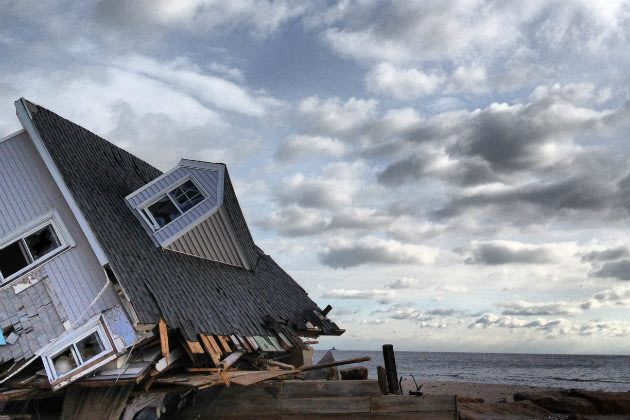A year after Superstorm Sandy, residents along the Atlantic and Gulf coasts should prepare for "an extremely active" 2013 hurricane season, U.S. forecasters say.
There is a "70 percent likelihood" that will be three to six major hurricanes this year with winds above 111 mph, according to the 2013 hurricane outlook unveiled by the National Oceanic and Atmospheric Administration's Climate Prediction Center on Thursday.

A house leveled during Superstorm Sandy in Fairfield, Conn. (Dylan Stableford/Yahoo News)
During the six-month hurricane season, which begins June 1, forecasters anticipate 13 to 20 named storms (winds of 39 mph or higher). Of those, seven to 11 could become hurricanes (winds of 74 mph or higher).
Those ranges are above normal. According to the National Hurricane Center, the seasonal average is 12 named storms, six hurricanes and three major hurricanes. Hurricane season ends Nov. 30.
The dire forecast comes as many shoreline residents—particularly in New York and New Jersey—are still recovering from Sandy, which killed 147 people and caused more than $75 billion in damage in October 2012. It was the second-costliest hurricane in U.S. history.
The 2012 hurricane season produced 19 named storms, including 10 hurricanes and two major hurricanes—Sandy and Michael, a Category 3 storm that stayed over the open Atlantic. The number of named storms and hurricanes were above average, but the two major hurricanes was below the average of three.
Climate factors—including warmer-than-average water temperatures in the Atlantic Ocean—contributed to 2013's active forecast, the NOAA said.
And homeowners should begin their storm preparations now.
"Take time to refresh your hurricane preparedness plan," Kathryn Sullivan, NOAA acting administrator, said during a news conference in College Park, Md., on Thursday. "Bottom line is become weather-ready now—that means starting today."
NOAA also unveiled plans for a new "supercomputer" that will run an "upgraded Hurricane Weather Research and Forecasting models." That, combined with new Doppler technology from NOAA's"hurricane hunter" aircraft, is expected to improve forecast accuracy "by 10 to 15 percent," the NOAA said.
========
Hoe to prepare:
Time Required: 5 hours
Here's How:
- Select a safe place for the family to weather the storm. This may be a location in your home -- consider a windowless room on the bottom floor. If your home doesn't have a safe area, you should know the locations of at least two emergency shelters near your home. If you have special medical needs and don't think you'll be able to get to the shelter on your own, contact the county in advance to make prior arrangements.
- Stock up on food and water. You should have enough non-perishable food and water in your home to last the family for at least a few weeks. If your stock of supplies is old, be sure to refresh it. You might want to purchase new canned goods every few years and rotate the rest through your pantry. Water should be replaced annually.
- Prepare other disaster supplies. You'll need to stock up on batteries, flashlights, rope, tarps, plastic bags, bad-weather clothing and other essentials to help you through the aftermath of a bad storm.
- Get your home ready. If you have hurricane shutters, make sure that you have all of the parts and have some extra screws/washers handy. If you don't, have a supply of plywood precut to fit your windows. Gather anything loose from your yard and store it in the garage. Watch the news when a storm is approaching and protect your home when advised by local authorities. If you wait until the rain starts, it may be too late.
- Develop a family communications plan. You might become separated before or after the storm. It's a good idea to have an out-of-state contact (a relative up north?) to act as the point of contact for all family members in the event of an emergency. Make sure everyone in the family knows who that person is and carries their phone number in their wallet or purse.
- Check your insurance coverage. Companies stop writing coverage when a storm is approaching. Ensure that your homeowner's insurance has enough windstorm coverage to rebuild your home in today's market. Also, remember that standard insurance doesn't cover flooding. You'll need special flood insurance from the federal government.
- Plan for the family pets. Shelters will not accept pets. If you want to ensure your pets livelihood, you may wish to consider evacuating early to a friend's home that's in a safe area.
- Keep your vehicles gassed up to at least half a tank at all times throughout hurricane season. When a storm approaches, lines WILL get long (up to five hours!) and gas stations will run out of gas before the storm hits. You need to have enough gas to safely evacuate if the situation warrants.
Visit the govt. site: http://www.nhc.noaa.gov/prepare/ready.phphttp://www.nhc.noaa.gov/prepare/ready.php
For saving yourself in case of tornados: Iowa university site: http://www.public.iastate.edu/~atmos/tornado_safety_rules.html
Also useful:
For saving yourself in case of tornados: Iowa university site: http://www.public.iastate.edu/~atmos/tornado_safety_rules.html
Also useful:
Comments